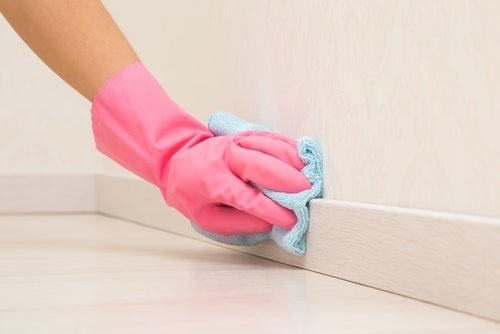How to Clean Baseboards

Cleaning baseboards doesn't have make your joints ache. AHS provides tips for the best way to clean baseboards.


Cleaning baseboards doesn't have make your joints ache. AHS provides tips for the best way to clean baseboards.
A dirty baseboard can make an otherwise spotless house look grimy, but how do you clean them without making your back and knees ache? Don’t fear—learn how to clean baseboards until they sparkle and gleam with these tips.
What Exactly Are Baseboards?
Baseboards are long, flat planks that cover the bottom of your home’s interior walls, hiding the awkward joint where the wall meets the floor. They are installed for both aesthetic and practical reasons; they protect the bottom part of the wall from getting banged and bruised by shoes, appliances, and furniture.
Most baseboards are made from solid wood. However, some homeowners choose to install composite materials, such as medium density fiberboard, or synthetic materials, like vinyl, due to price, durability, and resistance to mold and pests.
What To Use to Clean Baseboards
Here are the tools you’ll need:
The Best Way to Clean Baseboards
Follow these general steps to clean your baseboards:
1. Clean the walls
Much of the dust and dirt that collects on baseboards come from dirty walls, so it’s a good idea to vacuum and wash your walls before turning your attention downward.

2. Vacuum
This is one of the easiest ways to clean baseboards. Put the brush attachment on your vacuum and run it down the length of your baseboards. This step should remove most of the dust, dirt, and hair.

Learn how a home warranty helps cover unexpected system and appliance failures.

3. Wipe down the baseboards
After the dust is sucked away, it’s time to use a little elbow grease to get rid of any spills, stains, and splatters. The cleaning solution you use will depend on the baseboard material:

4. Get into the nooks and crannies
The best tools to clean baseboard nooks and crannies are cotton swabs or an old toothbrush. Dip your chosen tool into the cleaning solution. Then, scrub the top of the baseboard where it meets the wall and the bottom where it meets the floor. For an extra-squeaky clean, see if you can reach into the crevice between the floor and baseboard.
5. Buff it out
When the baseboards are dry, use a dryer sheet to wipe down the length of the plank. It will easily pick up any remaining dirt and dust from your newly shiny baseboards.
How to Clean Stained Baseboards
While the steps above will usually give you the gleaming baseboards of your dreams, sometimes your baseboards need a little extra love. If they have become stained from pet urine or other gunk, try using the following products on your baseboards:
If your wood baseboards are still discolored after using one of these cleaning solutions, you may need to sand off the top layer of varnish or paint and then replace it with another layer.
How Often Should You Clean Baseboards?
Your baseboard cleaning frequency depends on the baseboard type, your lifestyle, and who lives with you. For example, wood baseboards might mold more easily than vinyl ones, so you’ll want to clean them more often to protect your lungs. If you have a heavy-shedding pet or bring mud and dirt inside from your outdoorsy lifestyle, you’ll also want to clean your baseboards more often.
A good rule of thumb is to vacuum your baseboards once a month and clean up any spills immediately. From there, you can decide whether your baseboards need more attention or whether you can take a longer break in between cleanings.
Final Thoughts
To continue to safeguard your home against normal wear and tear, consider signing up for a home warranty plan. With coverage for parts of up to 23 major home systems and appliances and flexible pricing and plans, a home warranty from American Home Shield® means peace of mind that your home and budget are protected.
AHS assumes no responsibility, and specifically disclaims all liability, for your use of any and all information contained herein.
Have a plan for your home when things don't go according to plan
Shop Home WarrantiesDevelopment